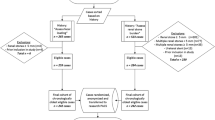Abstract
Subjective reporting of the color of blood passed per rectum has been used to predict the location of gastrointestinal bleeding, but the validity of this clinical approach has never been evaluated systematically. In this study we determined the spectrum of patient and physician descriptors used to characterize the color of blood passed per rectum and evaluated prospectively if an objective test of stool color would correlate with or improve upon subjective descriptions in predicting bleeding locations. The objective test employed was a card containing five numbered colors that typify the spectrum of stool blood colors. One hundred twenty patients used 23 different descriptors or terms to verbalize the color of blood they passed per rectum, and in 22% of cases there was a seeming discrepancy between their verbalized color and the color they pointed to on the test card. Patients pointing to card color 4 (the black color) resulted in a closer matching to an upper bleeding source than physicians using terminology such as melena or tarry stools. Likewise, patients picking card colors 1 and 2 (the brightest red colors) resulted in closer matching to a coloanorectal bleeding source than physicians using the terms hematochezia or bright red blood per rectum (P<0.02 for each comparison). The positive predictive value of card color 4 for an upper bleeding source was very high both when patients pointed to this color or when it was determined from the available stool (0.95 and 0.98, respectively). The positive predictive value of card color 1 for lower bleeding was greater for patients selecting this color than for a direct stool comparison (1.00 vs 0.83). This study revealed marked variability and surprising inconsistency in subjective color reporting for both patients and doctors and the superiority of several card colors for separating upper from lower bleeding sources. This simple objective test should improve upon terms such as melena and hematochezia and help direct the initial diagnostic evaluation of gastrointestinal bleeding.
Similar content being viewed by others
References
Hensyl WR (ed): Stedman's Medical Dictionary, 25th ed. Baltimore, Williams and Wilkins, 1990
Jensen D, Machicado G: Diagnosis and treatment of severe hematochezia. The role of urgent colonoscopy after purge. Gastroenterology 95:1569–1574, 1988
Zuckerman GR, Trellis DR, Clouse RE: The value of a pocket-sized stool-color card to localize the source of GI bleeding. Gastroenterology 100:A2Z, 1991
Edmundowicz S, Zuckerman G: Gastrointestinal bleeding.In Manual of Medical Therapeutics, 27th ed. M Woodley, A Whelan (eds.), Boston; Little, Brown, 1992
Luk G, Bynum T, Hendrix T: Gastric aspiration in localization of gastrointestinal hemorrhage. JAMA 241:576–599, 1979
Cuellar R, Gavaler J, Alexander J, Brouillette D, Chien M, Yoo T, Rabinovitz M, Stone B, VanThiel D: Gastrointestinal tract hemorrhage. The value of a nasogastric aspirate. Arch Intern Med 150:1381–1384, 1990
Snook J, Holdstock G, Bamforth J: Value of a simple biochemical ratio in distinguishing upper and lower sites of gastrointestinal bleeding. Lancet 1:1064–1065, 1986
Stellato T, Rhodes R, McDougal W: Azoemia in upper gastrointestinal hemorrhage. Am J Gastroenterol 73:486–489, 1980
Goldschmidt M, Ahlquist D, Wieland H, McGill D, Taylor W, Ellefson R: Measurement of degraded fecal hemoglobin—heme to estimate gastrointestinal site of occult bleeding. Appraisal of its clinical utility. Dig Dis Sci 33:605–608, 1988
Luke R, Lees W, Rudick J: Appearance of the stools after the introduction of blood into the cecum. Gut 5:77–79, 1964
Hilsman J: The color of blood-containing feces following the instillation of citrated blood at various levels of the small intestine. Gastroenterology 15:131–134, 1950
Tedesco F, Pickens C, Griffin J, Sivak M, Sullivan B: Role of colonoscopy in patients with unexplained melena: Analysis of 53 patients. Gastrointest Endosc 27:221–223, 1981
Author information
Authors and Affiliations
Rights and permissions
About this article
Cite this article
Zuckerman, G.R., Trellis, D.R., Sherman, T.M. et al. An objective measure of stool color for differentiating upper from lower gastrointestinal bleeding. Digest Dis Sci 40, 1614–1621 (1995). https://doi.org/10.1007/BF02212679
Received:
Accepted:
Issue Date:
DOI: https://doi.org/10.1007/BF02212679




